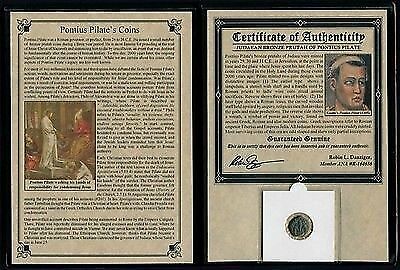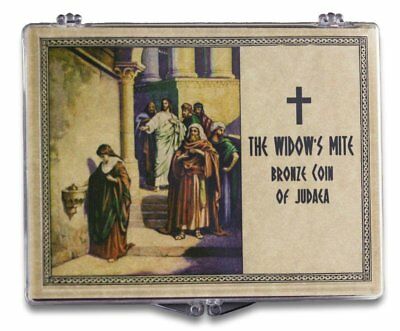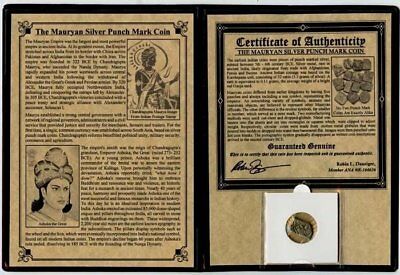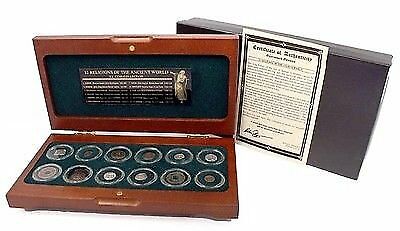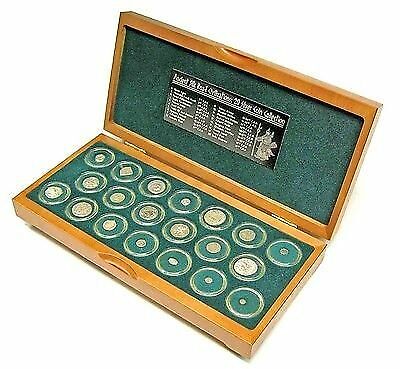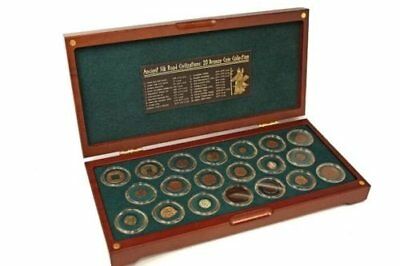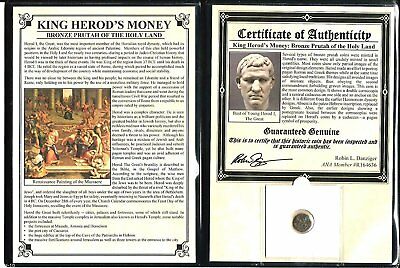-40%
The Jewish Wars with Rome: A Box of 6 Ancient Bronze Roman and Judaean Coins
$ 210.64
- Description
- Size Guide
Description
dsThe Jewish Wars with Rome:
A Box of 6 Ancient Bronze Roman and Judaean Coins
From the Rise of the Hasmonean Kings to the Fall of the Second Temple
The Maccabees threw off the yoke of the
Seleucids , establishing a new Jewish
kingdom, only for Rome to conquer
Judea a century later. This collection is
a numismatic history
o
f the Holy Land
in the tumultuous period from the rise
of the Hasmonean kings to the fall of the Second Temple .
Displayed in a Beautiful Mahogany-like Wood Box
with the story of the coins, the times
and a
"
Certificate of Authenticity
"
The Jewish Kingdom was established by King David after
the Siege of Jebus, when his armies liberated the Holy
Land from foreign rule. The period from about 1010 BCE
until the Babylonian conquest of 587 BCE is known as the
First Temple Period. Because the practice of minting
money did not emerge until later, there is no coinage
from the First Temple Period.
For four hundred years, the Jews were a conquered
people, subject to the whims of their rulers. Then, in 164
BCE, Judah the Hammer—
Maqqaba
in Aramaic; hence
Maccabee—led a rebellion against the forces of the
Seleucid king Antiochus Epiphanes, who had slaughtered
thousands of Jerusalem Jews by invading on the Sabbath.
Judah was the patriarch of the so-called Hasmonean
dynasty, whose first king,
John Hyrcanus I
, restored
Israel to Jewish power. The son of Simon Maccabaeus
and nephew of Judah Maccabee, J ohn took part in the
uprising against the Seleucid emperor
Antiochus VII
,
as described in the Biblical books of Maccabees,
assuming command when his father died. After being
vassals to Antiochus, the Jews under J ohn’s leadership
completely repelled the hated Seleucids from Judaea, doubling the size of their kingdom and granting them the
opportunity to mint the first Jewish coins.
When John died, his son Aristobulos declared himself king, but died after a reign of just a year. His brother
Alexander
Jannaeus
—nicknamed
“the Thracian” for his cruelty; he once massacred 50,000 of his own people for daring to rise
against him—ruled for more than a quarter-century, consolidating his hold on Judaea before drinking himself to death.
But this period of expansion would not last, for Rome loomed.
In 64 BCE, Pompey, the most powerful man in Rome, defeated the Seleucid Empire. The Young Butcher, as he was called,
set his sights on Judaea, where the sons of the dead king, Aristobulos and John Hyrcanus II, vied for supremacy. Pompey
ordered a suspension of hostilities so he could mediate, the cocky Aristobulos betrayed him, and the great Roman
commander unleashed the might of his army upon Jerusalem. For three months, Pompey’s army laid siege to the city,
before striking during Sabbath, executing the priests at the Temple, and violating the Holy of the Holies. Twelve thousand
were killed in the slaughter. Pompey assumed control of Judaea, installing Hyrcanus II as high priest. It was the first
major war between the Romans and Jews. It would not be the last.
The Second Temple Period was at its apex during the reign of
Herod the Great
. A brilliant politician who enjoyed
excellent relations with Rome, he was also a paranoid madman who ruthlessly executed anyone he deemed a threat to his
absolute power, whether legitimate rivals, family members, or innocent babies. Crowned King of the Jews by the Roman
Senate, Herod ruled from 40 BCE until his disease-ridden death 36 years later. A prodigious builder, Herod expanded the
Second Temple in Jerusalem, a magnificent complex, of which only the famed Western Wall remains. He constructed
fortresses at Masada, Antonia, and Herodium; the port city of Caesarea; the huge edifice atop the Cave of the Patriarchs in
Hebron; and massive fortifications around J erusalem, as well as three towers at the city’s entrance.
Herod Archelaus
was next in line, ruling Judaea until 6 CE. Once a bosom friend of the mad Caligula, his removal from the throne by the
emperor was indicative of the volatile relationship between Rome and Judaea.
Tensions reached a fever pitch in the year 66, when Jewish rebels, tired of living under imperial rule, revolted. The rebels
were tenacious, but the Romans were too strong. The
Jewish revolt
effectively ended when the Romans destroyed the
Temple and much of Jerusalem in 70 CE, although the fighting continued for three more years, ending with the mass suicide at Masada in 73.
The Coins:
1. John Hyrcanus Issued: 134-104 BCE
Material: Bronze
Weight: 1.7-2.4 g
Obverse: Hebrew inscription
Reverse: Double cornucopia
Denomination: Prutah
Diameter: 12-14.5 mm
2. Antiochus VII/w-Hyrcanus I
Issued: 138-129 BCE
Material: Bronze
Weight: 2.2-2.6 g
Obverse: Lily
Reverse: Seleucid anchor
Denomination: Prutah
Diameter: 13 – 16.5 mm
3. A. Jannaeus Issued: 103-76 BCE
Material: Bronze
Weight: 1.1-2.2 g
Obverse: Hebrew inscription
Reverse: Double cornucopia
Denomination: Prutah
Diameter: 12-14 mm
4. Herod I Issued: 37-4 BCE
Material: Bronze
Weight: 1.2-1.9 g
Obverse; Anchor
Reverse: Double cornucopia
Denomination: Prutah
Diameter: 12-13.5 mm
5. Herod Archelaus Issued: 4 BCE-6 CE
Material: Bronze
Weight: 0.8-1.8 g
Obverse: Helmet or Prow of galley
Reverse: Grapes or Wreath
Denomination: Prutah
Diameter: 12-14.5 mm
6. First Revolt Issued: 66--70 CE
Material: Bronze
Weight: 1.5-3 g
Obverse: Crude amphora
Reverse: Vine leaf
Denomination: Prutah
Diameter: 15-18 mm
Images shows coins, not to scale
Coin images shown for illustration purposes, grades may vary in the collection.
All coins in each set are protected in an archival capsule and beautifully displayed in a mahogany-like box.
The box set is accompanied with a story card, certificate of authenticity, and a black gift box.
Box measures: 7.25” x 5.5”
DISCOUNT ON SHIPPING FOR MULTIPLE PURCHASES
FASTEST SHIPPER ON EBAY
ALL MY ITEMS ARE SHIPPED THE DAY OF PURCHASE IF PAID BEFORE 12:00PM.
ALL ITEMS PAID AFTER 12:00PM WILL BE SHIPPED THE NEXT DAY…
*** GUARANTEED ***
***
Please don’t hold me responsible for the Post office shipping time when leaving feedback
***
Thank You for your Purchase and Please come back soon
All orders come with a 5% discount card good for your next purchase
Not Responsible for any further charges including Customs.
If unsure about Customs charges contact the Customs Office in your Country
All coin orders over .99 gets a
FREE Ancient Roman Coin

